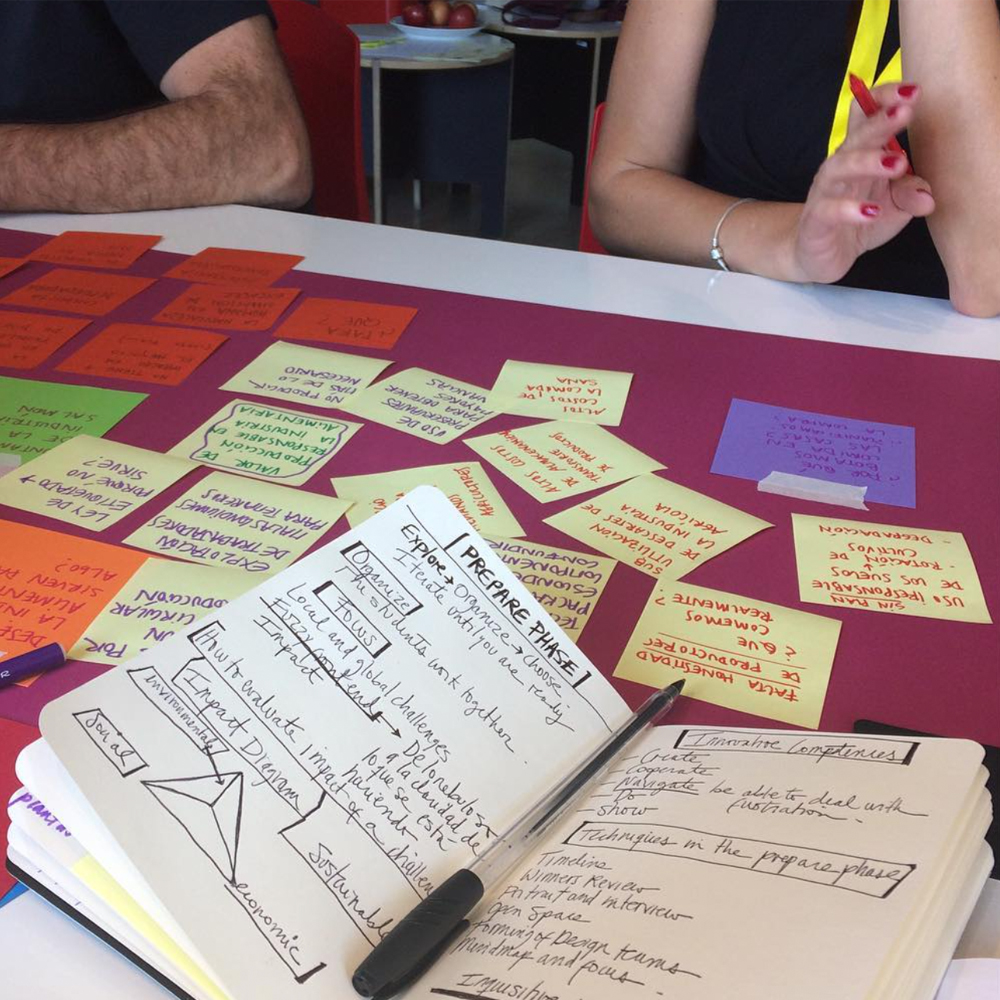Infusing Sustainability
A Compass-Led Intervention in Chilean Graduate Design Education
DOI:
https://doi.org/10.7577/formakademisk.5525Emneord (Nøkkelord):
Design for sustainability, interdisciplinary design, The Compass method, Design to Improve Life.Sammendrag
Design for Sustainability has evolved rapidly over the last decades as a response to unprecedented global challenges. Several models have been developed to address the need to design more sustainable products, services, and policies. These strategies are oriented towards more sustainable ways of living. The Compass, developed by the Index Project in Denmark, is a method that offers a framework to structure the design process while considering social, environmental, and economic sustainability aspects. This article presents an exploratory case study to infuse sustainability in design education using this method in interdisciplinary teams. The context is a master’s degree offered by a design school in a Chilean university. The study's outcomes reveal that The Compass method is a dynamic and flexible structure for design in interdisciplinary teams. To strengthen its applicability, it could incorporate links to sustainability methods from various areas of knowledge that specifically address economic, environmental, or social aspects. Complementing The Compass with these sustainable approaches to confront the complexity of the challenges may facilitate the move from good ideas to feasible, sustainable design solutions in design and other fields.
Referanser
Andrews, D. (2015). The circular economy, design thinking and education for sustainability. Local Economy, 30(3), 305–315. https://doi.org/10.1177/0269094215578226
Andrews, D., Newton, E. J. & Lishman, B. (2021). Rethinking and adapting approaches to Education for Sustainability to address cultural and behavioural change and challenges. In H. Grierson, E. Bohemia & L. Buck (Eds). Proceedings of the 23rd International Conference on Engineering and Product Design Education (E&PDE 2021), VIA Design, VIA University in Herning, Denmark. 9th -10th September 2021. https://doi.org/10.35199/EPDE.2021.24
Boehnert, J. (2015). Ecological Literacy in Design Education: A Theoretical Introduction. FormAkademisk, 8(1), 1–11. https://doi.org/10.7577/formakademisk.1405
Bowen, G.A. (2009). Document analysis as a qualitative research method. Qualitative Research Journal, 9(2), 27–40. https://doi.org/10.3316/QRJ0902027
Braungart, M., & McDonough, W. (2002). Cradle to Cradle: Remaking the Way We Make Things. North Point Press.
Brundiers, K., Wiek, A. & Redman, C.L. (2010). Real‐world learning opportunities in sustainability: from classroom into the real world, International Journal of Sustainability in Higher Education, 11(4), pp. 308–324. https://doi.org/10.1108/14676371011077540
Brezet, H., & Van Hemel, C. (1997). Ecodesign. A Promising Approach. Paris.
Ceschin, F., & Gaziulusoy, I. (2016). Evolution of design for sustainability: From product design to design for system innovations and transitions. Design Studies, 47, 118–163. https://doi.org/10.1016/j.destud.2016.09.002
Coskun, A., Zimmerman, J., & Erbug, C. (2015). Promoting sustainability through behavior change: A review. Design Studies, 41, 183–204. https://doi.org/10.1016/j.destud.2015.08.008
Denham, D., Rozance, M. A., Malone, M., & Goodling, E. (2021). Sustaining future environmental educators: building critical interdisciplinary teaching capacity among graduate students. Journal of Environmental Studies and Sciences, 11(1), 101–114. https://doi.org/10.1007/s13412-020-00611-y
Ellen MacArthur Foundation. (2015). Towards a Circular Economy: Business Rationale for an Accelerated Transition. Ellen MacArthur Foundation. https://www.ellenmacarthurfoundation.org/towards-a-circular-economy-business-rationale-for-an-accelerated-transition
Gaziulusoy, A., & Öztekin, E. E. (2018). Design as a Catalyst for Sustainability Transitions. In C. Storni, K. Leahy, M. McMahon, P. Lloyd & E. Bohemia (eds.), Design as a catalyst for change - DRS International Conference 2018, 25-28 June, Limerick, Ireland. https://doi.org/10.21606/drs.2018.292
Goodland, R. J. A. (1989). Environmental sustainability in economic development: A comment. Land Degradation & Development, 1(4), 311–322. https://doi.org/10.1002/ldr.3400010407
Goodland, R. (1995). The Concept of environmental sustainability. Annual Review of Ecology and Systematics, 26, 1–24. https://www.jstor.org/stable/2097196
Huerta, O. (2021). Diseño para la sostenibilidad: Soluciones a largo plazo para un problema complejo [Design for sustainability: long-term solutions to a complex problem] Base Diseño e Innovación, 6(5), 19–27. https://revistas.udd.cl/index.php/BDI/article/view/740/599
Koyama, D., & Watanabe, T. (2023). Why a dispositional view of ecological literacy is needed. Teaching in Higher Education, 28(5), 1108–1117. https://doi.org/10.1080/13562517.2023.2198637
Lutnæs, E. (2021). Framing the concept design literacy for a general public. FormAkademisk, 14(4), 1–17. https://doi.org/10.7577/formakademisk.4639
Merriam, S. B. (1988). Case study research in education: A qualitative approach. Jossey-Bass.
Micklethwaite, P. (2022). Sustainable Design Masters: Increasing the sustainability literacy of designers. Sustainability, 14(6), 3255. https://doi.org/10.3390/ su14063255
Orr, D. W. (1992). Ecological literacy: Education and the transition to a postmodern world. Suny Press.
Papanek, V., & Lazarus, E. L. (2005). Design for the Real World: Human Ecology and Social Change (Ed. 2). Thames & Hudson.
Reigado, C. R., Fernandes, S. D. C., Saavedra, Y. M. B., Ometto, A. R., & Da Costa, J. M. H. (2017). A Circular Economy Toolkit as an Alternative to Improve the Application of PSS Methodologies. Procedia CIRP, 64, 37–42. https://doi.org/10.1016/j.procir.2017.03.034
Stegall, N. (2006). Designing for Sustainability: A Philosophy for Ecologically Intentional Design. Design Issues, 22(2), 56–63. Retrieved from https://doi.org/10.1162/desi.2006.22.2.56
The Index Project. (2012). INDEX Design to Improve Life Teacher´s Guide. https://theindexproject.org/
United Nations, (1987). Our Common Future, Chapter 2: Towards Sustainable Development. Report of the World Commission on Environment and Development. https://sustainabledevelopment.un.org/content/documents/5987our-common-future.pdf
United Nation (n.d.). UN Sustainable Developmental Goals. https://sdgs.un.org/goals

Nedlastinger
Publisert
Hvordan referere
Utgave
Seksjon
Lisens
Opphavsrett 2024 Catalina Cortes, Oscar Huerta

Dette verket er lisensiert under Creative Commons Attribution-NoDerivatives 4.0 International License.
- Forfatteren(e) beholder sin opphavs- og kopieringsrett til eget manuskript, men gir tidsskriftet varig rett til 1) å fremføre manuskriptet for offentligheten i den opprinnelig publiserte digitale form, og 2) å registreres og siteres som første publisering av manuskriptet.
- Forfatteren må selv forvalte sine økonomiske kopieringsrettigheter overfor eventuell tredjepart.
- Tidsskriftet gir ingen økonomisk eller annen kompensasjon for innsendte bidrag, medmindre det er gjort særskilt avtale om dette med forfatteren(e).
- Tidsskriftet plikter å arkivere manuskriptet (inklusive metadata) i den opprinnelig publiserte digitale form, i minst ett dertil egnet åpent tilgjengelig langtidsarkiv for digitalt materiell, som for eksempel i de norske universitetenes institusjonsarkiv innen rammen av NORA-samarbeidet.
Verket vil bli publisert OpenAccess med en Creative Commons 4.0-lisens som tillater alle å lese, dele og tilpasse innholdet, også kommersielt, under lisensvilkårene:
Dette verket må tilskrives/ krediteres på riktig måte, en lenke må gis til CC-BY 4.0-lisensen, og endringer som er gjort må angis på en rimelig måte, men ikke på noen måte som antyder at lisensgiveren støtter deg eller din bruk.



